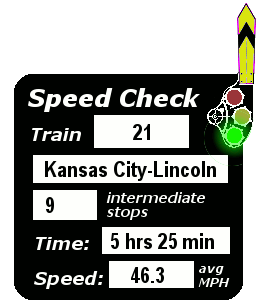



Time:
A - A.M.
D - Train stops only to discharge passengers
F - Conditional (Flag) stop
I - Customs/Immigration inspection stop
M - Meal stop
N - Not a passenger stop
P - P.M.
R - Train stops only to receive passengers
Services:
A - Auto loading/unloading facilities (as freight)
B - Checked baggage is handled
C - Coupon station (Ticket office)
I - International border inspection station
M - Food service available
P - Telephone station
R - Rental cars available
T - Telegraph station
X - Checked baggage NOT handled





Following tests on the Reading in Pennsylvania where the little trainset hit a top speed of 104 mph, it was officially unveiled to the press and public at Philadelphia's Broad Street Station on April 18, 1934. But its real introduction to the world came little over a month later; after transiting the Burlington's route with stops at major cities between Chicago and Denver, it was poised to make the run in reverse for a record. As a nationwide radio audience listened in, the Zephyr whistled off from Denver at dawn (5:05 a.m) of May 26, headed for Chicago at top speed. According to the Wikipedia entry for the train, Burlington called in additional manpower to make sure that every single grade crossing between Denver and Chicago was protected by a flagman. The train reached Chicago. 1015.4 miles away, at 7:10 p.m. having averaged nearly 78 mph. From there the little trainset went directly to the Chicago "Century of Progress" World's Fair exhibition, where the waiting crowds went wild.
Following its own nationwide publicity tour, the new Zephyr (named for the Greek god of the west wind) entered revenue service on November 11, 1934 between Lincoln, Omaha and Kansas City. But Burlington already had numerous additional streamliners on order from the Budd company, and they could see that with the Zephyr they had created more than a train—it would be a franchise. Aptly, then, as the additional equipment came on line the original 9900 trainset was renamed the Pioneer Zephyr.